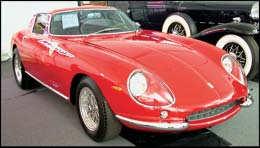More than a few self-proclaimed market gurus have been running around like the proverbial chickens with their heads removed, all aflutter because the Euro has appreciated by over 25% against the dollar in the past few months. Visions of container after container being filled in Long Beach with old cars, and destined for England, Holland or Germany fill their heads.
Well, it’s always nice to have something to get excited about. But let’s take a little closer look at the picture.
First, it is just a tiny segment, although a highly visible one, of the car market that is affected by any currency swing. Further, the economy in Europe is still in the toilet, far worse than the situation in the US, as their central banks have been slow to cut interest rates to get things moving again. Further, the endemic economic problems caused by the cradle-to-grave care offered by most European governments continue to bedevil their economic planning.
What this means is that even though prices of cars in America may be falling relative to the Euro, there still aren’t a lot of Europeans out there buying cars, certainly nothing like the gold rush of 1988-91. Of course, the rich are different. Especially the European car-collecting rich.
More than anything else, what sets European collectors apart is the way they use their cars. Unlike the American preoccupation with sanitized, beautified concours and tea-cup racing, where, when two cars enter a corner, each driver is expected to graciously say to the other, “After you,” Europeans hammer their cars.
For instance, in the recently completed Modena Cento Ore, 275 GTB/C S/N 7271 GT fell off the road in the final special stage, and bounced off a few trees before coming to rest. The owner’s reaction? “Where’s the nearest carrozzeria? I need to get this thing fixed before the next event.”
As events like the MCO, Tour Auto and Tour d’España become more popular, Europeans have begun to scour America for cars. And because so many of these cars were originally sold in the US, there are still barn-finds or unrestored original cars to be found. After the sprinkling of a few hundred thousand Benjamins, second-tier Ferraris such as Boanos, Lussos and 275 GTB/2s can be made competitive in their classes, with a total outlay of one-third that what an SWB or TdF would cost.
Project cars—such as alloy-bodied Boanos, Lussos and 275 GTB/2s—that can be converted into relatively low-dollar (in the Ferrari world) priced GT racers are the most sough-after model today, with project alloy-body Boanos and Lussos bringing as much as $150,000 and project 275 GTB/2s bringing as much as $175,000.
Restored alloy-body Boanos will bring $250,000-plus in the US, restored Lussos will bring $200,000-plus and restored 275 GTB/2s will bring as much as $300,000-plus. Today, these prices are cheap for Europeans, so these cars are going overseas.
As an example of the market swing, I sold 250 Lusso S/N 5859 GT to England in February for $195,000 US. The same 250 Lusso is now being offered, only four months later, by an English dealer for 195,000, which is €273,000 or $315,000.
I only know of one first-tier car that has gone to Europe recently, 250 LM S/N 6105, and I can only speculate at the buy and sell prices. I believe the buy was $2,200,000 and know the car was bought by an English dealer. We’ll have to watch the adverts to see what he hopes to get for it.
I also sold 333 SP S/N 012 to Europe in May. With current exchange rates, it was simply cheaper than any of the 333 SPs on the market in Europe, even after adding in freight and import duty.
While I don’t traffic in Jaguars, Austin-Healeys or Porsches, conversations with dealers that do sell these cars confirm the same trends. Anything that can be raced, from a Jaguar 120 to a Healey 3000 or a Porsche 356, has a better chance of selling, for higher dollars, to a European buyer than an American one. This is especially true for ratty cars, essentially sale-proof in the US, that can become good platforms for event cars.
While Lussos and 275 GTBs are crossing the Atlantic at a rapid rate, the American market for production cars such as Daytonas continues to show token appreciation, while 550 Maranellos, 456 GTs and even 360 coupes continue their predictable pattern of depreciation. Certainly the devaluation of the dollar has had a catastrophic effect on the gray market, as there’s no way to buy a late-model serial-production Ferrari in Euros, pay for it to be legally imported into the US, and come out ahead. So if you’ve got a nasty Lusso, or a very early 911, or a Jag 120 roadster with a decent body but a trashed engine, you might just have better luck getting good money for the car from a European buyer than from an American one. But if you are thinking of selling, I urge you to move fast. Currency swings are as much a matter of economic policy as they are of business realities, and if the world suddenly decides it wants a stronger dollar, it’s a stronger dollar we’ll see.


